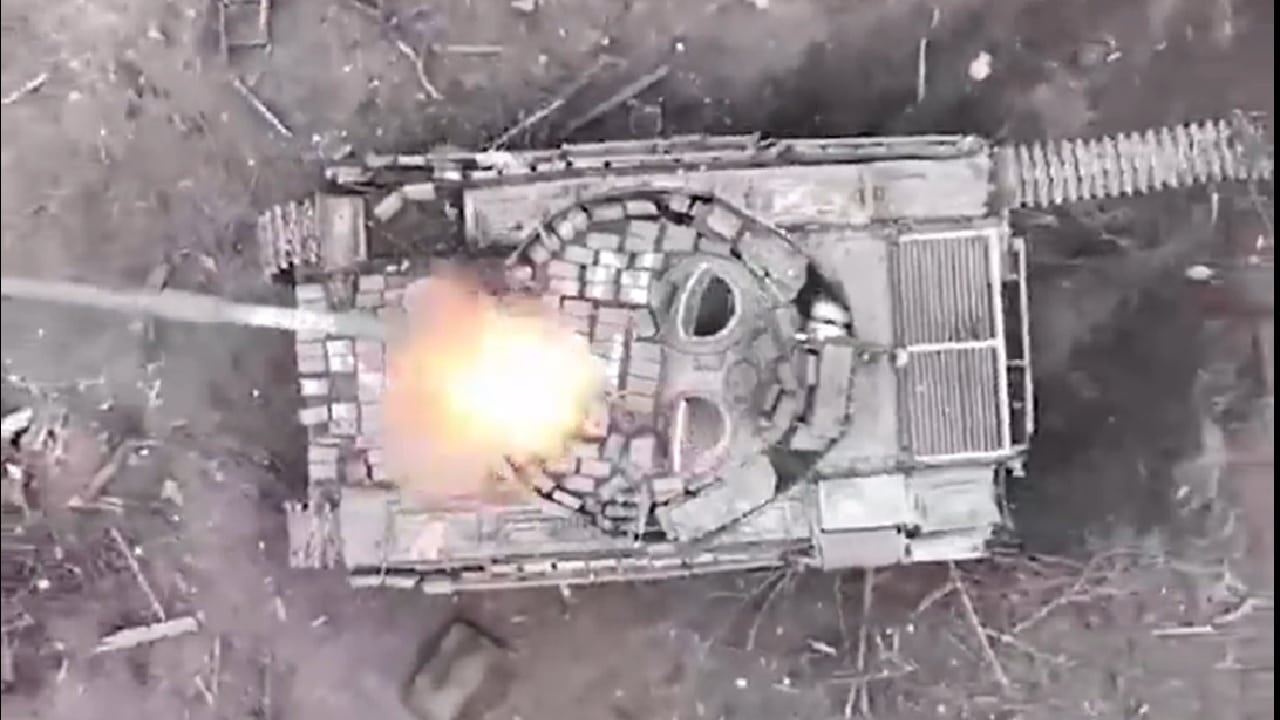See Russian T-72B Destroyed by Drone and Grenade: Video footage shared recently once again shows Ukrainian soldiers destroying Russian tanks in eastern Ukraine using just a drone and a grenade.
The clip shows the drone’s view of the tank from above. The drone sees three hatches open, suggesting the tank had already been abandoned. The drone operator drops an F-1 grenade right into the open driver’s hatch and quickly rises into the air to avoid the blast.
What initially looks like a small explosion turns into a roaring fire, consuming the entire tank.
Later in the video, the fire is seen spreading for meters around, and additional explosions also occur as ammunition and other components of the tank begin to combust.
Ukraine Weapons Tracker, a popular war-tracking Twitter account, noted that the video was recorded somewhere in Donetsk Oblast and added that the vehicle had been detracked – meaning the tank’s tracks were destroyed, damaged, or had come loose.
“A detracked Russian T-72B tank was destroyed in #Donetsk Oblast by a precise drone-dropped F-1 grenade- straight into the driver’s hatch,” the account notes.
Tanks typically lose their tracks after driving over anti-tank mines, though the vehicle could have also been hit by all manner of Ukrainian ammunition.
Meet the T-72
The T-72B is one of several Soviet-era tanks still in use by both the Russian and Ukrainian militaries. Ukraine was gifted an unknown number of modernized T-72B tanks by Morocco in January. The tanks were reportedly upgraded in the Czech Republic.
Poland and Ukraine Launch Joint to Manufacture Soviet-Era Ammunition for Tanks
Ukraine’s state arms producer, Ukroboronprom, announced on Thursday its plans to form a new joint manufacturing effort for 125-mm rounds designed for use in Soviet-era tanks. The project will be a collaboration with Polish arms producer Polska Grupa Zbrojeniowa (PGZ).
Poland becomes the second NATO member state to assist Ukraine in manufacturing new ammunition for older equipment, and the new ammunition will ensure that Ukraine’s remaining Soviet tanks can be used as part of an expected new counteroffensive.
The agreement was signed during President Volodymyr Zelenskyy’s trip to Poland earlier this week and will see Ukrainian technology sent to manufacturing facilities in Poland.
The location of the factories will remain secret, not just to prevent Russian strikes on Polish territory – a move that would effectively trigger a new world war – but also to make it more difficult for Russian forces to anticipate the direction from which the new ammunition will travel from when it is ready to be sent to Ukraine.
#Ukraine: A detracked Russian T-72B tank was destroyed in #Donetsk Oblast by a precise drone-dropped F-1 grenade- straight into the driver’s hatch. pic.twitter.com/MpeoiNqwrl
— ???????? Ukraine Weapons Tracker (@UAWeapons) March 28, 2023
In a statement, PGZ said that the project will result in the production of “large numbers of ammunition for 125-mm tank guns.”
Jack Buckby is 19FortyFive’s Breaking News Editor. He is a British author, counter-extremism researcher, and journalist based in New York. Reporting on the U.K., Europe, and the U.S., he works to analyze and understand left-wing and right-wing radicalization, and reports on Western governments’ approaches to the pressing issues of today. His books and research papers explore these themes and propose pragmatic solutions to our increasingly polarized society.

